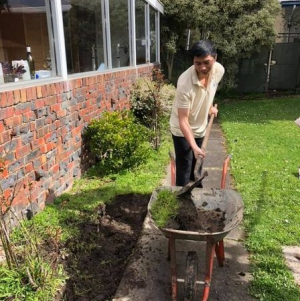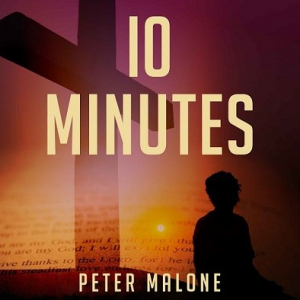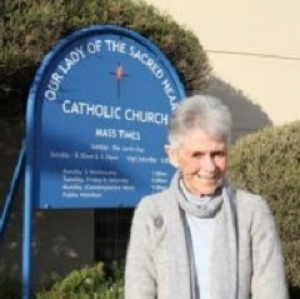Peter MALONE
Becoming Cousteau

BECOMING COUSTEAU
US, 2021, 93 minutes, Colour.
Directed by Liz Garbus.
Before his death in 1997 at the age of 80, French diver, Jacques-Yves Cousteau, was an international figure, honoured by national leaders around the world. This is a documentary tracing his career as a diver, his contribution science and innovation, especially the aqualung (leading to scuba developments), his expeditions, his films and television series, his growing realisation about the destruction of the oceans, his becoming a universal campaigner and crusader.
This film was made for National Geographic and has that audience strongly in mind, an audience who appreciates films about the wonders of nature, especially in underwater life, but also audiences who are committed to the preservation of world heritage to falling s. It is not a biography of Cousteau although there are some personal elements of his life throughout the film. For those who want a feature film version of his life, the French film, The Odyssey (2016), stars Lambert Wilson as Cousteau, Audrey Tautou as his wife, Simone, and Pierre Ninny any as his son, Philippe. (Although some aspects of Cousteau’s personal life, especially his second family and his second wife are alluded to in The Odyssey but made quite explicit in Becoming Cousteau.) The Dir of this documentary, Liz Garber’s, has a very strong and long list of documentary achievements, especially documentaries about Marilyn Monroe, Gloria Vanderbilt and Nina Simone.
There are many scenes with Philippe Cousteau who worked with his father on the boat, for the television programs, scenes of bonding with his father – and the sad accident of his death.
Cousteau is a genial screen presence. There are many interviews, television appearances, addresses to international organisations. The filmmakers have the advantage of the Cousteau archives, a great range of photographs starting with his childhood, a great range of home video material, of black-and-white footage, colour material, and excerpts from his films and documentaries. They give quite a round picture of Cousteau and his achievements.
The film pays tribute to his early life, an accident and having to swim to overcome it, his exhilaration in the discoveries of diving, his work in the Navy – and his forever afterwards being referred to as Captain Cousteau, his development of the aqualung during the 1940s (the film not mentioning his work in the Resistance), the collaboration with friends enabling divers to spend longer times underwater and go deeper. He wrote a book, The Silent World, 1954, filmed and Oscar-winning in 1956. This began a long career of film and television making, awards, popularity in the US, and beyond.
However, Cousteau went through something of a conversion experience. Early film shows some brutality in landing sharks and battering them. Cousteau and his team, with his re-conditioned boat, Calypso, were invited to help in the underwater search for oil. Cousteau says in the 1970s that he watched The Silent World again and repudiated much that was in it. He then became an international crusader for the preservation of the oceans, showing sequences of coral reef devastation (an alert to Australians about the Great Barrier Reef), contamination, pollution, refuse and garbage in the sea.
He was the leading speaker at the United Nations Conference in Rio de Janeiro in 1992, gaining pledges of countries around the world (including glimpses of a very affable Fidel Castro), and the development of his Cousteau Foundation.
Cousteau’s long life was completely in the 20th century – but, his work and inspiration are more relevant than ever in the 21st-century.
Nixon by Nixon: In his own words

NIXON BY NIXON: IN HIS OWN WORDS
US, 2014, 71 minutes, Colour.
Directed by Peter W.Kunhardt.
This is a brief but powerful documentary. It is made up of clips from Nixon’s tapes, which were all finally made available by 2013.
The principal tapes are from those that Nixon made, taping the interviews and discussions in his office. However, the filmmakers go back to newsreel footage, speeches made by Nixon, at social events, politically, campaigning in 1960 as well as in 1970 1968 and 1972.
The overall impact of this film is negative concerning Nixon and his personality, his attitudes and motivations, his political life. It does go back into his California background, his Quaker family, his upbringing and education, his interest in politics, activities in the 1950s, especially connected with Senator Joe McCarthy.
There are many conversations, the text printed out for greater clarity, and an indication as to who was at the other end of the telephone, especially the significant members of his staff, and especially with Henry Kissinger.
The Nixon who is revealed is an ambitious man, brooking no opposition, resentful towards enemies. And, in his remarks, those chosen for this film, he emerges as anti-Semitic, racist against black Americans, misogynistic, not wanting women in positions of power and legal authority. At times, he has a foul mouth.
The film traces his downfall, Senate investigations, the work of the Washington Post journalists, his resignation and farewell – and some interviews with him afterwards, commenting and giving his own assessment of his life, especially of his political life.
This film will reinforce negative attitudes towards Richard Nixon.
Nothing Left Unsaid: Gloria Vanderbilt and Anderson Cooper
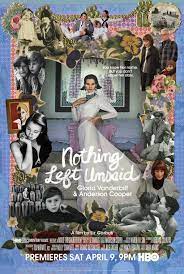
NOTHING LEFT UNSAID: GLORIA VANDERBILT & ANDERSON COOPER
US, 2016, 108 minutes, Colour.
Directed by Liz Garbus.
This is a portrait of heiress, Gloria Vanderbilt, daughter of rail-wealthy Reginald Vanderbilt and Gloria Morgan. She was famous as a child by being the “poor little rich girl”, having lived with her socialite mother in Paris during the 1920s-1930s, not bonding with her, subject to the custody case and the decision that she go to live with her aunt, the artist and the founder of the Whitney Museum, Gertrude Whitney. While she was cared for, and had a great deal of money, she went off to Hollywood at a young age, was caught up in the glamour of Hollywood, married a mobster, Pat di Cicco, divorced him, married the famous conductor, Leopold Stokowski, forty plus years her senior, had two children, divorced him. She also married the film director Sidney Lumet. Finally, she married Wyatt Cooper and had two sons. She was a socialite, tried acting on stage and screen, was a model, much photographed, created designer jeans, was an artist. Filming this documentary, she was in her early 90s, dying at the age of 95 in 2019. Her story was told in the television film, Little Gloria… Happy at last, with a star cast including Angela Lansbury, Bette Davis, Christopher Plummer.
What makes this documentary distinctive is that it is actually a video memoir, discussions between Gloria Vanderbilt and her son, journalist and war correspondent, Cooper Anderson, who is a custodian of her archives and documents.
The moral of the story, almost cliche, is that money can’t buy happiness.
Gloria Vanderbilt emerges from this film quite admirably. She has lived through a very difficult life, wealthy, over-protected, continually breaking out, making extraordinarily bad judgements, yet surviving, and able to look back over her past with a more critical eye than she was able to while she was living it. She is well aided by Anderson Cooper, sympathetic, care for his mother, able to ask are all kinds of questions about the past, able to talk about his own relationship with his father, his childhood, the impact of the suicide of his brother in front of his mother.
There are various locations for the video memories and discussions, but all intercut and edited to give an overview of Gloria Vanderbilt’s life. There is a great deal of newsreel footage, home movie footage, clips from newsreels, clips from films. And there is always a gallery of celebrities throughout. However, there are interviews with her oldest son, Stan Stokowski (his younger brother, Chris, long alienated from his mother). There are commentary from a Vanderbilt cousin who is historian of the family. There is some pathos in the interviews with Pearson Marx, the girlfriend of Carter Cooper who suicided.
Gloria Vanderbilt was never afraid of being in front of the camera. And there is some attention to her being made up for sequences, her being dressed for occasions. But, for a woman in her early 90s and who has had such a chequered life, she is a sprightly and active interviewee.
19th century America and early 20th century America produced an extraordinary number of millionaires, empires, tycoons, wealth, separation from ordinary people. The Vanderbilt stories this kind of story.
Direction is by Liz Garbus who made significant documentaries about Marilyn Monroe, Jacques Cousteau and Nina Simone.
The Colony/ Tides
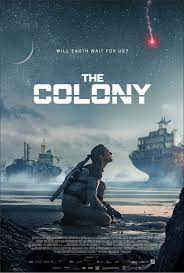
THE COLONY/ TIDES
Switzerland/Germany, 2021, 104 minutes, Colour.
Nora Arnezeder, Iain Glen, Sarah-Sofie Boussninia, Sope Dirisu, Sebastian Roche, Joel Basman, Kotti Yun, Eden Gough.
Directed by Tim Fehlbaum.
There seems to be a large contingent of fans for films about outer space. There are films about space exploration. There are films about space colonisation. There are films that aim at reality. There are many more that have the elements of science fiction, even science-fantasy.
TID/
The Colony (aka Tides, acknowledging the watery surface of the planet and so much of the action taking place on small boats and wrecks of large ships) is somewhat different. As expected, Earth has been devastated by climate change and other catastrophes, and inhabitants have fled to a distant planet, Keppler. But, this time it is the inhabitants from Keppler who are planning to return to Earth. There has been a failed mission. The film opens as we accompany the econd mission, the small space team approaching earth and crash landing.
At the centre of the action is the astronaut with technical and medical expertise, Louise, a very strong action-hero of this kind of film, played by Nora Arnezeder. The early part of the film is quite eerie, the discovery of some human beings still on earth, living in squalor and destitution, highly suspicious of the intruders from space, imprisoning them. While the audience is wondering where this can all go, the small colony is attacked by what look like vicious pirates, a number of them taken prisoner, including a little girl who has been kind to Louise. Leadership in the colony is exercised by the little girl’s mother, fierce in her attitude, setting out to rescue her daughter and the others, Louise following.
What follows consists of revelations about the previous expedition, some success, the rounding up of young girls – with the revelation that the inhabitants of Keppler are unable to conceive children, the settlement on Keppler is about to die out, there is a need to transport these young girls from Earth back to the planet.
There are also some flashbacks to Louise as a little girl, her relationship with her scientist father, his ambitions for Keppler and going on the expedition, his mantra instilled into his daughter, not to be selfish, but everything to be “For the many”.
Louise is welcomed by the head of the mission, Gibson (Iain Glen), treated with some suspicion by his military associate, cheered by her meeting with the young girls being prepared to go to Keppler. There is also a little boy, his Chinese mother, part of the new generation on Earth.
Of course, there will be some revelations about double dealings, power grabs, the dilemma for Louise, her concern for the girl who helped her who has now become part of the group for Keppler, issues as to where her loyalties lie.
Which means that there are some fight scenes and confrontations at the end. Just as the final credits begin, there is a momentary scene indicating what the future might be.
Which also means that this is probably a film only for the space film fans.
- The title? The colony on Earth? The alternate title, Tides? The water and the tides on Earth, the small boats, the large ships? Action on water? Underwater?
- The future, post-apocalyptic, the inhabitants of the planet, Kepler, survival, civilisation, impotence and no further children? The missions back to earth, the first failed mission, the audience landing with the second mission?
- The goal of the second mission, the crash landing, Louise and her abilities, medical, spacecraft, her companion, his injuries?
- The locals, taking Louise and her partner, in the well, his death? Her coming out, wanting the equipment, the medical equipment? Her reaction to the locals, language and communication? The sympathetic little girl? The hostile woman leader?
- The attack on the colony, seeming pirates, the violence, taking prisoners, on the boat? The woman, venturing out, Louise following her, the confrontation, knocking her unconscious, going to the ship?
- The flashbacks, Louise as a girl, working with her father, his ambitions, skills, hopes, teaching his daughter, “For the Many”?
- The ship, the mission from Kepler, the introduction to Gibson, his being in charge, smooth manner, sympathetic, introducing Louise to the young girls, the plan for them to go back to Kepler, his son, the Chinese mother? This singing for Louise?
- Gibson’s assistant, violent, unpleasant, his coming on to Louise, her reaction?
- The little girl, her being made part of the group, helping Louise? The mother? Louise later restoring her to her mother?
- Louise, finding her father, explanations? Gibson becoming the villain?
- The buildup to the confrontation, the fight, Gibson and Louise in the water, her killing him?
- Survival, the woman helping Louise, the rescue of the children? And the revelation the little boy was her half-brother? His significance in the resolution of the crisis?
- A futuristic space exploration and colonisation film for the fans?
It’s the middle of Spring today. Humour from the days when we used to go to Church. May it happen again
It’s the middle of Spring today. Humour from the days when we used to go to Church. May it happen again.



Laudato si and MSC Formation – the backyard of Cuskelly House, Blackburn
Laudato si and MSC Formation – the backyard of Cuskelly House, Blackburn

The long Melbourne lockdown fosters activities at home.

In the garden.

Hard work and vegetables

and Danh having a break from Siloam.

A Rainy Day in New York

A RAINY DAY IN NEW YORK
US, 2019, 93 minutes, Colour.
Timothee Chalamet, Elle Fanning, Liev Schreiber, Jude Law, Diego Luna, Selena Gomez, Will Rogers, Rebecca Hall, Griffin Newman, Ben Warheit, Cherry Jones.
Directed by Woody Allen.
The release of Woody Allen’s 2019 film was delayed by controversies about the director with consequent restricted release.
It is extraordinary to think, while watching the film and its typical Woody Allen dialogue and quips, that it is the work of a man in his early 80s. And, having made a film almost every year for 40 years, there is great respect for his body of work.
Yes, this is a day in New York and there is quite an amount of rain and people getting wet. The focus, surprising for the elderly writer director, is that the central characters are aged 20 or so. Timothee Chalamet plays Gatsby (do affluent New Yorkers actually call their sons Gatsby!), a dropout from prestigious colleges, slumming it so to speak in a minor school, pressurised all his life to be a culture vulture by his ambitious mother, mainly successful at winning large sums of money at poker. But he is infatuated with a bright young thing, winner of Miss competitions, from Tucson, Arizona, Ashleigh, played with verve by Elle Fanning (probably reminding audiences of a young Diane Keaton, la di da). Actually, Ashleigh is a combination of earnest student journalist and easy airhead (and when asked by the director during an interview whether she would like a scoop, she replies “of what?”).
While the couple intend to spend the day together in New York that is not how it works out. She goes off to the interview with the moody director played by Liev Schreiber. His associate is played by Jude Law (whose wife, Rebecca Hall, is conducting an affair with his best friend). Ashleigh’s day, with Gatsby’s encouragement, is going to the interview, watching the film, getting tangled with the director’s emotions, looking for him, trying to calm him down, then finding a fickle and stereotypical Hispanic film hero (Diego Luna), who is her dream star, going to a party, drinking too much, prepared to be seduced, but, finally walking in the rain to find Gatsby.
Meanwhile Gatsby has had a day of encountering friends, some of whom mock him, another who asks him to do a cameo in the film he is making, a kiss with Chan (Selena Gomez), the sister of one of his former flames. He visits his brother who is having second thoughts about getting married to his fiancee who has a horrendous cackle when she laughs. He goes to a gallery with Chan, is discovered by an uncle and aunt – and shamed into going his mother’s social evening which he intended to avoid. Depressed, he still wins an enormous amount of money at poker, pays an escort $5000 to impersonate Ashleigh at the party, and is unmasked by his mother.
Which means then that in 90 minutes, there is a lot going on. There is a series of vignettes, excellently played, full of Woody Allen situations, ironies, farcical moments, wisecracking dialogue. And, quite an unexpected vignette towards the end involving Cherry Jones as Gatsby’s mother.
Gatsby, we realise from the beginning, has a young Woody Allen look, something of a world-weary stoop, delivers his lines in the old Woody Allen manner and intonation and pacing. And, as the film continues, Gatsby becomes more like Woody Allen and a Woody Allen-like character from the past. Is the director reinterpreting his life?
As with most Woody Allen films, they are brief, light, a stepping stone in the annual event of a Woody Allen film. But, with Allen in his mid-80s, is this coming to a close?
- A Woody Allen film from his early 80s? The New York setting, his love for New York? Characters and situations, old and young? His perspective on young characters? His love of music, the wide range of songs, Jazz?
- The picture of New York, the vistas, the buildings, the streets? Hotels, socials? Street film sets? Film studios?
- The action taking place over one day? The hopes of the day, for Gatsby, for Ashleigh, together? The rain? The couple together, the plans? Ashleigh’s day, meeting the director, the interview, watching the film, changing plans, the consequences? Gatsby’s day, wandering, the former student criticising him, the friend and the film set, meeting Chan, memories of her sister, the film scene, the kiss? Ashleigh changing the plans?
- The cast, the range of characters, their different worlds? And their dialogue, Woody Allen style, quips, comedy? Questions about life, and just, careers, fidelity and infidelity, fame?
- Gatsby’s character, his age, family background, his mother and education, pushing him, his rebellious attitude, dropping out of college, going to Yardley? His skill at poker and winning money?
- A Woody Allen film from his early 80s? The New York setting, his love for New York? Characters and situations, old and young? His perspective on young characters? His love of music, the wide range of songs, Jazz?
- The picture of New York, the vistas, the buildings, the streets? Hotels, socials? Street film sets? Film studios?
- The action taking place over one day? The hopes of the day, for Gatsby, for Ashleigh, together? The rain? The couple together, the plans? Ashleigh’s day, meeting the director, the interview, watching the film, changing plans, the consequences? Gatsby’s day, wandering, the former student criticising him, the friend and the film set, meeting Chan, memories of her sister, the film scene, the kiss? Ashleigh changing the plans?
- The cast, the range of characters, their different worlds? And their dialogue, Woody Allen style, quips, comedy? Questions about life, careers, fidelity and infidelity, fame?
- Gatsby’s character, his age, family background, his mother and education, pushing him, his rebellious attitude, dropping out of college, going to Yardley? His skill at poker and winning money? Meeting Ashleigh, attracted, love? The plan for the day, avoiding his mother’s party? His wanting to show her New York, her eagerness? The contrast with Ashleigh, from Arizona, banking background, winning competitions, at college, journalism, eager? Smart in some ways, ingenuous in others?
- Ashleigh, the director, his moodiness, giving her a scoop, watching the film, his walking out, drinking, the producer asking her to bring him back? In the car with the producer, his watching his wife, the affair? The club, fighting the director, his inviting her to Europe and come away with him? Her going to the studio, the encounter with the film star, her infatuation? Going with him, being seen, the paparazzi? On television and Gatsby seeing her? His apartment, the beginning of the affair, his girlfriend coming home, Ashleigh escaping, underwear, the overcoat, the rain? Meeting Gatsby again? The discussions, her hopes, the break?
- Gatsby, the friend insulting him in the street, the film and the kiss, exasperation with Ashleigh, going to visit his brother, the planned wedding, the fiancee, the jokes and her hyena-laugh, meeting Chan again, going to the Gallery, hiding from his uncle and aunt, the phone call? Forced to go to the social, his gambling, winning the money, meeting the escort, paying her the money to impersonate Ashleigh, at the social?
- Gatsby and his mother, her pressures, the talk? Audiences and gas be amazed at her revelation of her past, the escort, her plans, marrying her husband, the pressures on Gatsby? His resembling her?
- Meeting with Chan, all a conversation about her sister and the relationship? Gatsby’s future?
New Book, Peter Malone MSC, 10 Minutes, Gospel Reflections for Mind and Heart
New Book, Peter Malone MSC, 10 Minutes, Gospel Reflections for Mind and Heart

All Scripture is inspired by God and can profitably be used for teaching, for refuting error, for guiding people’s lives and teaching them to be holy.
2 Timothy 3:16
10 Minutes is a fresh way to approach the study of the Bible. Take 10 minutes, it suggests, to read a chapter in the book that will introduce a Bible story that will lead to another 10 minutes of reflection, prayer and sharing. The approach is described as ‘writing your own Gospel’ – inviting us to recall our own versions of the life and teachings of Jesus – those favourite passages that have shaped our personal (and group) identities as disciples within the community called the church.
The approach acknowledges that this approach probably reflects how the original stories were remembered, shared, modified and finally written down in the four Gospels in our New Testament. It is also an approach that, in our times, recognises the effect of film, stage and television on how those ancient messages have been shaped and recalled.
The reflections in 10 Minutes will move our hearts and minds to learn anew the revelation of what our God is like through the life of Jesus and the teaching of the Gospel.

This collection is a delightful synthesis of treasures that quite naturally invites the reader into prayerful reflection ̶ treasures that truly will stimulate minds and move hearts.
Anne McAtomney, Director, Chevalier Institute, Kensington
_________________________________________
10 Minutes is a delightful invitation to get to know Jesus more personally and make meaning for one’s life.
Helena Goldsmith, Catholic Mission and Identity, Melbourne Archdiocese Catholic Schools (MACS)
__________________________________________
Firmly rooted in Scripture, laced with literary and cinematic references and journeying down the path of Visio Divina (Spiritual Watching), the twenty essays on life and faith will make us ponder, smile and read them again, and again.
Paul Beirne, Director. Heart of Life Centre for Spiritual and Pastoral Formation, Malvern.

Peter Malone is a Missionary of the Sacred Heart. He taught Old Testament Studies and Theology at the Yarra Theological Union and conducted Spirituality seminars at the Heart of Life Centre for Spiritual and Pastoral Formation. He has written Jesus… According to the Scriptures and Hearts Burning Within Us for Lectio Divina. He headed SIGNIS, The World Catholic Association for Communication, and has written several books on cinema, theology and spirituality including Screen Jesus and Screen Priests.
An OLSH story, Helen Armstrong
An OLSH story, Helen Armstrong

Jenny Brinkworth, Southern Cross Catholic News SA July 29, 2021 (Reprinted in the MSC Magazine, 2021)
Sr Helen Armstrong is adamant she would never have had such a “fascinating life” if she hadn’t been a member of the Daughters of Our Lady of the Sacred Heart (OLSH).
Her vocation has taken her to places such as the Tiwi Islands, the Philippines and South Africa where she has immersed herself in the local culture and followed her order’s motto of ‘may the Sacred Heart of Jesus be everywhere loved’.
Sr Helen has taught at OLSH schools in Melbourne, Sydney, Darwin and Bathurst Island, studied spirituality and formation in the United States, supervised novices in Manila, and raised funds and coordinated a program for orphans and vulnerable children in Limpopo, South Africa. Her latest ministry is providing pastoral care in the parish of Henley Beach.
“When I look back, I think what an extraordinary life I have had and what wonderful opportunities I’ve been given,” Sr Helen, 75, said.
“There’s no way I would have been able to do it all if I wasn’t a Religious, I wouldn’t have had the freedom or the resources to do it.”
Sr Helen said while there may have been times when “things were difficult” she never had any doubts.
“I always felt that this is where I should be, I’ve loved our charism – God loves you and wants you to respond in love to others – it’s been the driving force of my whole life.”
Her long association with the Daughters of OLSH began as a child growing up in Maroubra Beach in Sydney where she was educated by the Sisters at St Michael’s, Daceyville, followed by Our Lady of the Sacred Heart College at Kensington.
“When I was in high school I was inspired and moved by the dedication of a couple of the Sisters in the school,” Sr Helen recalled.
“I suppose that sparked off something in me and I felt like God was calling me. At the beginning of each school year we had farewell to the girls from the previous year who were entering (the convent) and that ignited something again.”

On the home front, her father was a lapsed Catholic but her mother, who only converted to Catholicism 10 days before she died, made sure her twin daughters and son said their prayers and went to Mass.
“My parents were married in the sacristy because they couldn’t wed inside a church, but my mother took seriously the promise she made to raise her children Catholic,” Sr Helen said.
“She wasn’t bitter, and she loved the nuns.”
With her father insisting she go to teachers’ college for a year before entering the convent, Helen was 19 when she joined the OLSH novitiate at Burradoo, in the southern highlands of NSW.
Her memories are of a beautiful place where, in full habit, the novices would play sport, garden and “do everything”.
In January 1968, she made her first profession and moved to Kensington in Sydney where she undertook further studies in scripture and theology with Religious from other orders.
After upgrading her teacher training qualification, Sr Helen taught at a parish primary school in Melbourne and a year later was sent to Darwin to teach at St Mary’s Catholic School.
Sr Helen said going to Darwin was “like being set free”.

“It was a wonderful experience…there were a lot of Aboriginal children in the school, it really broadened you,” she said.
Her next posting was even more of an eye-opener – teaching Tiwi children at an OLSH school on Bathurst Island.
The families of her students gave her a totem and called her by her Aboriginal name because ‘Helen’ was too close to ‘Alan’, the name of a deceased elder.
She had two 12 month stints on the island, in between teaching in Sydney and Darwin, and loved the experience but she admitted being shocked when she first arrived and saw people living on the beach in tin shacks.
Her next big adventure came when an American Jesuit who had been in Australia invited some of the OLSH Sisters to Gonzaga University in Spokane, Washington.
It was her first time out of Australia and she made the most of the opportunity by travelling all over America with another Sister by Greyhound bus.
After a “wonderful” 21/2 years Sr Helen went to the Philippines where she was in charge of formation of novices in Manila.
“The Filipinos were lovely people,” she said. “Extraordinarily happy yet poor … and very hard-working.”
Returning to Australia, she took on the role of principal of St Mary’s in Darwin.
[An addition to the article, Helen had three years in a special role in Kensington parish, administrating and living in the presbytery, while Philip Malone was the parish priest while teaching at St Paul’s Late Vocation Seminary, 1996-1998, a parish experiment which may have been ahead of its time.]

Her life took a very different turn in 2009 when she agreed to go to Limpopo Province in South Africa to work for the Diocese of Tzaneen which was established by the Irish province of the Missionaries of the Sacred Heart in 1950.
As development officer and director of orphans and vulnerable children programs, she coordinated projects that involved assisting more than 1000 children in eight parishes with school uniforms, books, food parcels and monitoring of health, particularly for those children requiring medication for HIV AIDS.
Sr Helen said many children were orphaned because their parents had died of AIDS or were vulnerable because of the high incidence of sexual and physical abuse and neglect.
Initially involved with sourcing significant funding for the projects, Sr Helen then had responsibility for supervising and monitoring local carers, while also assisting another Sister to run a project that trained girls to sew and set up cottage industries in their villages.
The Sisters also ran a program for young adults providing tuition fees, accommodation, clothing and other items while they completed secondary or tertiary studies.
“It was very demanding and some days you’d feel like you’d been wrung out like a dish rag,” Sr Helen said.
“But we had a lot of fun, and I made some really nice friends…it’s a beautiful country.”
A highlight of her time in Limpopo was helping prepare for, and attending, the beatification of Blessed Benedict Daswa, a South African school teacher who was killed for his Catholic faith and opposition to traditional witchcraft.

Returning to Sydney at the beginning of 2020, Sr Helen was asked by Fr Paul Cashen msc to come to Adelaide to work in the MSC’s Henley Beach parish.
“He thought with COVID forcing people to be shut in I could be some sort of a pastoral presence here,” she said.
Worried that she might not have enough to do, Sr Helen said she “hasn’t stopped” since she arrived and has been visiting people in aged care and in their homes as well as assisting with other parish duties.
She is enjoying living by the sea at Semaphore but isn’t tempted to reignite her childhood love of bodysurfing.
“It needs to be 50 degrees (Celsius) for me to go in,” she laughed.
Abe
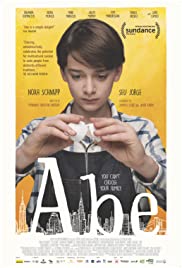
Abe
US, 2019, 85 minutes, Colour.
Noah Schnapp, Seu Jorge, Dagmar Dominczyk, Arian Moayed, Mark Margolis, Tom Mardirosian, Salem Murphy, Daniel Oreskes.
Directed by Fernando Grostein Steen Andrade.
While the setting is Brooklyn, New York, the issues are those of Palestine and Israel, the conflict before 1948 and since 1948, embodied in Americans of both traditions. Interestingly, the film was cowritten and directed by a Brazilian Director (who introduces Brazilian themes into this New York story).
Abe (a genially convincing performance from Noah Schnapp from Stranger Things) is a 12-year-old, only child of a Jewish mother and a Palestinian father who do not impose either religious tradition on him, leaving choices to him. He wants to combine both, praying in Hebrew and in Arabic at meals, combining Jewish traditions like bar mitzvah with Islamic traditions like Ramadan.
There are various visits and meals from the older generation from each side, his father’s parents, his mother’s grandfather and uncle. Neither side has approved of the marriage, is eager to offer condemnations at times, very critical in telling stories about the past as well as the conflicts of the present. They embody the Israeli-Palestinian conflict at the table.
This is a film also for the social media age and for the younger audience, identifying with Abe and experiencing his cultural issues in the light of the traditional conflict. The of texting, phones, postings, instagram
Abe loves cooking and reads of Brazilians coming to the city and goes to visit the kitchen, Chico being the chef (Brazilian star, Seu Jorge, Elite Squad, City of God). After some hesitation, permission to do menial work around the kitchen, Chico helps the young boy with varieties of recipes and cooking styles with Abe bringing food from his traditions. He thrives.
The dramatic climax of the film is his 12th birthday where he prepares food from both traditions, says opening prayers in Hebrew and Arabic, is more and more dismayed by the hostility between the older generations, criticisms of the parents and their not bringing the boy up well. He runs away and takes refuge in Chico’s kitchen.
There are some apologies, some calming down, everyone eating the food that Abe had prepared, some kind of reconciliation – and hope. (The documentary, Breaking Bread, about a chef’s competition between Israelis and Palestinians could be an interesting companion piece.)
- The title, Abe and his names, Abraham, Ebrahim?
- The Brooklyn setting, homes, restaurants and kitchens, parks and fairs?
- The interreligious household, the Jewish mother, the Palestinian father? Her grandfather and uncle? His parents? The household symbolic of Palestine-Israel? Conflict? Resolution – or not?
- Abe, his voice-over, explanation of the situation, his love for cooking? Seeing him at work in the kitchen, recipes, mixing, cooking?
- A film for the social media age, the appeal to younger audiences, to a children’s audience? The use of texting, film and comment, the range of social media?
- Abe, the possibility of cooking camp, his first visit, the young children? The information about the Brazilians, their work in New York, bringing their own kitchen, the blend with the Americans? Abe and his going to visit, Chico and his concern, law and deportation, the employment of children? Giving him the food?
- Chico, his personality, Brazilian background, his staff, the work, the recipes? His giving Abe jobs, clearing, washing, cleaning? Eventually introducing him to the cooking, Abe and his learning, experimenting, bringing his own ethnic recipes? His enjoying the work in the kitchen?
- The meals at home, the discussions, Jewish prayers, Islamic prayers, the parents and giving Abe his choices? His wanting to combine the two? The different religious celebrations, fasting for Ramadan, the bar mitzvah? The older generation the disapproval?
- Abe enjoying the summer, learning from Chico? Going out, the passers-by, sales, the range of food for sale?
- Abe, showing his experiments on line, posting images? The range of comments?
- His 12th birthday, the cake, his decision to prepare the meal, food from both traditions? The opening and his great combination from both religious traditions? The older reactions? The food, the discussions, discussions about parenting, Abe’s parents and their temporary separation, responsibility, accusations? Abe continually bringing the food, beginning to weep, leaving? Going to Chico in hiding?
- The parents, the elders, distraught, the search, the discussions, some apologies, calming down, eating the food? Going to Chico’s? Chico and his advice for Abe?
- Abe, a means of reconciliation, food?

